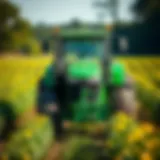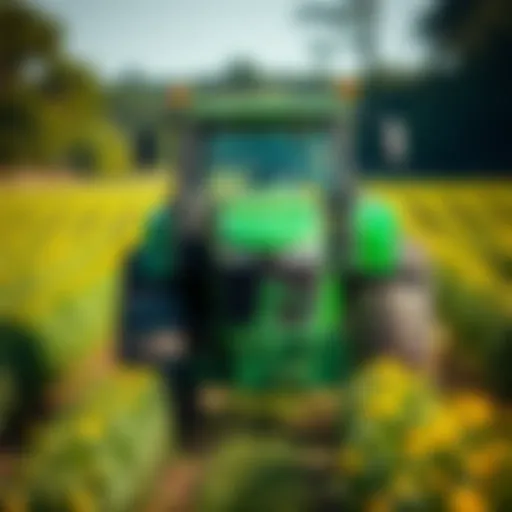Effective Strategies for Grass Removal in Your Yard


Intro
Removing grass from your yard can feel like a daunting task. However, understanding effective strategies is key to transforming your outdoor space. Whether it's due to undesirable grass species taking over or simply a desire to explore new landscaping options, the rationale behind turf removal varies among homeowners and garden enthusiasts alike.
By adopting the right approach, you can reclaim your yard for other uses, whether that’s creating a vibrant flower garden, establishing a vegetable plot, or even installing a patio for outdoor relaxation. This article dives into various methods of grass removal, evaluating their effectiveness while also weighing their environmental impacts—and let’s not forget those post-removal maintenance tips.
Next, we’ll take a look at the latest trends that shape grass removal methods, which can help you stay ahead of the curve in your gardening endeavors.
Latest Trends in Agriculture
Overview of Current Trends
In today’s fast-paced agricultural environment, technology and innovation play a significant role in how we handle grass and weeds. More homeowners are leaning toward methods that blend traditional techniques with modern advancements. This fusion gives rise to trends such as solarization, where sunlight is harnessed to heat the soil, effectively cooking the grass. Moreover, eco-friendly practices are being adopted, ensuring that methods chosen are less harmful to the environment while still effective.
Impact of Technology on Farming Practices
Technological innovations are reshaping how we approach yard management. Tools like robotic lawn mowers and soil sensors are not just reserved for commercial farming but are being embraced by homeowners as well. These gadgets can help monitor grass growth, optimize watering, and even apply herbicides when necessary, thus reducing water usage and increasing efficiency.
In addition, apps that provide tailored gardening advice are on the rise, making it easier for users to manage their outdoor spaces just with a few taps on their smartphones.
"Adopting modern gardening technology empowers homeowners to manage their yards more effectively while respecting nature’s boundaries."
Sustainable Practices: Towards a Greener Future
Importance of Sustainability in Agriculture
Sustainability is no longer a buzzword; instead, it's become a vital aspect of yard care. When considering grass removal, methods that minimize chemical use and promote soil health are crucial. Non-toxic options like vinegar or soap mixtures can be used to tackle unwanted grass without damaging the ecosystem.
Methods for Sustainable Farming
Several sustainable practices can be employed in removing grass:
- Mulching: Covering the grass with organic material suffocates it while feeding the soil.
- Composting: Turning grass into nutrient-rich compost offers a dual benefit when removing unwanted growth.
- Natural Herbicides: Citrus oils or corn gluten meal can deter unwanted grasses without chemical pollutants.
Gardening Techniques and Tips
Essential Gardening Tools and Equipment
Equipping yourself with the right tools is essential for effective grass removal and ongoing yard maintenance. Essential items might include:
- Hand Trowels: Perfect for digging up smaller patches.
- Garden Forks: Good for loosening soil and uprooting established grass.
- Weed Barriers: Using fabric or plastic to block sunlight and inhibit growth post-removal.
Seasonal Gardening Practices
Being aware of seasonal changes can greatly enhance the results of your grass removal efforts. For instance:
- Spring: Ideal for early intervention, as many grass types begin to emerge.
- Summer: May require more water and care for new plants once grass is removed.
- Fall: A good time to plan for the subsequent year, allowing for adequate preparation of the soil.
For more detailed tips on different gardening techniques, feel free to visit Wikipedia Gardening or explore community forums on sites like Reddit Gardening.
Prologue to Grass Removal
In the realm of yard maintenance, the act of removing grass plays a significant role. It's not merely about creating an aesthetically pleasing garden or lawn; it encompasses a variety of practical reasons that homeowners may need to consider. Furthermore, with the evolving environmental awareness among gardeners and farmers, understanding the motivations and methods of grass removal has never been more crucial. By delving into this topic, one can discover not just the strategies for effective removal, but also the philosophy behind why certain methods may fit specific contexts better than others.
Understanding the Need for Grass Removal
Grass can take over a yard like a weed on steroids, often leading to a landscape that feels unkempt or difficult to maintain. However, the need for grass removal often arises from deeper concerns about land use, aesthetics, and plant health. Homeowners, especially those who are keen on cultivated gardens, sometimes find themselves at odds with native grass species. These grasses may crowd out desired flowers or vegetables, competing for essential nutrients, sunlight, and water.
Moreover, some yards harbor invasive grass species that can wreak havoc if left unchecked. These nuisance plants can prove detrimental to local ecosystems, disrupting native habitats and soils. By understanding the specific needs of the garden and the nature of what grows, one can make an informed choice about whether the grass should stay or go.
The conscientious gardener won't simply pull up grass without a thought. Instead, they strategize, taking into account the best practices for healthy soil and thriving plants. Removing grass can pave the way for more sustainable landscaping practices and thoughtful designs that welcome biodiversity, making proactive removal an essential part of effective garden management.
Common Reasons for Removing Grass


There are several common motivations behind the decision to remove grass from a yard, each with its unique implications:
- Creating a Garden Bed: Many homeowners wish to cultivate flower gardens, vegetable patches, or even xeriscaping initiatives. Here, removing grass facilitates a more hospitable environment for plants.
- Eliminating Weeds: In some cases, removing grass can help in uprooting weeds that thrive among the blades. When grass is thick, it can obscure invasive weeds, making it tough to eradicate unwanted growth.
- Improving Drainage: In areas where grass creates drainage problems, removal can lead to better water flow and reduced pooling, enhancing the overall health of the landscape.
- Aesthetic Changes: Changing the look of a yard is often a driving factor, allowing homeowners to reimagine their outdoor spaces according to their tastes. Putting a fresh face on a tired lawn can invigorate the entire atmosphere of a home.
Ultimately, whatever the rationale, it's vital to have a plan. The correct techniques for grass removal can mean the difference between a thriving garden ecosystem and an unsightly patch of earth. Understanding the reasons behind your choice will help guide you to the most effective removal strategies tailored for your specific circumstances.
Assessment of Your Yard
Understanding the layout and condition of your yard is a crucial first step in any grass removal project. By thoroughly assessing your yard, you’ll gain insights into what methods will be most effective and which areas need the most attention. This process is not merely a preliminary step but a foundational strategy that sets the stage for successful grass management. When you know your yard well, you can avoid wasting time and resources, making your efforts both efficient and effective.
Evaluating Grass Types and Their Growth Patterns
A vital aspect of assessment involves identifying the types of grass growing in your yard. Each grass variety has its unique characteristics, growth patterns, and seasonal tendencies. For instance, Bermuda grass thrives in the summer heat, while Kentucky bluegrass prefers cooler climates. By knowing what you're dealing with, you can tailor your removal strategy appropriately.
Sometimes, grass types can even indicate health or environmental issues in your soil. For example, persistent weeds might suggest a lack of nutrients or imbalance. Analyzing these growth patterns can help you make informed decisions about how to proceed, whether through mechanical means or natural methods. Here are some common grass types you might find:
- Bermuda Grass: A heat-loving perennial, usually found in southern regions.
- Fescue: Prefers cooler weather and has a dense growth habit.
- Zoysia: Tolerates a range of conditions but grows slowly in the spring.
Understanding your specific grass type offers a roadmap for removal methods and future planting options.
Determining the Extent of Grass Coverage
Next, it’s essential to evaluate how much of your yard is covered in grass. Not all areas require the same level of intervention; some patches may only need a light touch-up, while others could be choked with invasive species. By visualizing where grass growth is heavy, sparse, or problematic, you can prioritize your efforts more efficiently.
This assessment includes walking around your yard and taking notes or even drawing a simple map of grass coverage. Note any areas that might seem particularly stubborn or invasive. Tools like a plotter could be helpful for marking sections that need removal. After your assessment, try to categorize the areas based on:
- Lightly Covered Areas: May require minimal intervention.
- Moderate Coverage: Might need mechanical or natural removal with some follow-up care.
- Heavily Overgrown Sections: Likely need substantial effort, including potential use of chemical methods in some cases.
As you organize your findings, consider the long-term vision for your yard. Will you replace the removed grass with fresh plants or leave some areas bare? A solid plan can help maintain soil health and prevent unwanted regrowth. Ultimately, a thorough assessment allows you to tackle the grass removal process methodically, ensuring you’re equipped with the knowledge necessary for success.
"A careful observation of your yard today can lead to greener choices tomorrow."
For further guidance on identifying grass types and their growth patterns, consider visiting resources like Wikipedia or University Extension sites dedicated to gardening.
Mechanical Methods of Grass Removal
When it comes to reclaiming your yard from the grasp of unwanted grass, mechanical methods are often the most direct and effective approach. These techniques not only provide immediate results but also allow for precise control over the area being treated, making it easier for homeowners and garden enthusiasts alike to customize their landscapes. Understanding the different tools and machines available can greatly enhance the effectiveness of your yard management efforts.
Using a Lawn Mower
A lawn mower is not just for mowing; it can serve a greater purpose in grass removal. When adjusted to cut low, it can effectively chop off the top growth of the grass, allowing sunlight to penetrate more deeply into the soil and preparing the area for further treatment. This method is particularly handy when you don’t want to deal with overlapping roots.
Pros include:
- Quick and easy: You can cover large areas swiftly, which saves time.
- Immediate visual results: A freshly mowed lawn instantly looks different, even if the roots remain.
However, the downside is that it doesn't remove the roots. If left unchecked, the grass will likely regrow, so further treatment may be necessary. Often, mowers come with bagging features that can help collect the cut grass, reducing the amount of organic matter left behind.
Employing a Tiller
A tiller is a powerful tool designed to break up the soil, making it an excellent option for more thorough grass removal. By turning over the soil, a tiller uproots grass and roots, disrupting their growth cycle and giving you a better chance to establish new plants. The process aerates the soil, allowing nutrients to circulate and contribute to a healthier yard.
Considerations when using a tiller include:
- Soil type: Heavy clay or rocky soil can be challenging for tillers. Make sure your soil is suitable or find a tiller designed for tough conditions.
- Depth of removal: A tiller can go deeper than a mower, potentially getting rid of more unwanted grass.
Nevertheless, it's crucial to ensure that the tilling is done at the correct depth. Till too shallow, and you won’t eliminate the roots; too deep, and you might disrupt soil layers that affect health in the long run.
Utilizing a Sod Cutter
For those looking to remove large patches of grass efficiently, a sod cutter is a must-have tool. This device slices through the turf, cutting it away in manageable strips. It’s specifically designed for removing sod while minimizing soil disturbance, making it less of a hassle when creating a new garden bed or landscape.
The benefits are clear:
- Efficient grass removal: Cuts straight edges, making it easier to replant or refashion areas without leftover grass.
- Less labor-intensive: Compared to manual removal, a sod cutter saves your back and speeds up the process.


Keep in mind that sod cutters can be a bit more expensive than other options and may require some level of experience to operate. Additionally, after cutting, proper disposal of sod is necessary, so consider the logistics of handling and compost or discard the old grass properly.
"Choosing the right mechanical method for grass removal ultimately depends on the size of the area, the type of grass, and your landscaping goals."
Incorporating mechanical methods for grass removal can set you up for success in transforming your yard. Not only do they offer speed and efficiency, but they also pave the way for preparing the terrain for whatever new life you want to cultivate.
Chemical Methods of Grass Removal
When it comes to clearing grass from your yard, chemical methods offer a potent avenue to consider. This section will take a closer look at why and how these methods can be effective. The application of chemical solutions can not only expedite the removal process but also ensure thoroughness which is often hard to achieve with mechanical methods alone. Understanding the intricacies of herbicides, including their appropriate uses and safety measures, will equip homeowners and garden enthusiasts alike with critical knowledge..
Herbicides and Their Application
Herbicides are chemical agents designed to eliminate unwanted plants, including grass. They come in various formulations, each tailored to specific types of vegetation and levels of infestation. Using herbicides correctly involves several steps, from selecting the right product to applying it properly.
- Types of Herbicides: There are two primary types — selective and non-selective herbicides. Selective herbicides target specific species, leaving other plants unharmed, while non-selective ones do not discriminate and will kill any green vegetation they come in contact with. It's important to choose based on your goals and yard conditions.
- Timing is Key: Applying herbicides during the right season is pivotal. Most herbicides perform best during the growth season of the grass you want to eliminate. In many cases, late spring or early summer is optimal, as the plants are actively growing and more susceptible to these chemicals.
- Application Techniques: Ensure that you follow the manufacturer’s guidelines for application. This typically involves using a sprayer for even coverage and avoiding windy days which might cause drift that can harm desirable plants nearby.
Systemic vs. Contact Herbicides
Understanding the difference between systemic and contact herbicides is crucial in making an informed choice for grass removal.
- Systemic Herbicides: These products are absorbed by the plant and move throughout its systems, effectively killing it from the inside out. Systemic herbicides are beneficial for targeting deep-rooted grasses since they can reach the root systems where other methods might fail. However, they take longer to work, often a week or more, as they need time to circulate within the plant.
- Contact Herbicides: In contrast, contact herbicides kill only the parts of the plants they touch. These provide immediate results, often within hours. However, they may not be effective against perennial grasses as they tend not to attack the root system directly. For a quick reduction of visible grass, contact herbicides are a reasonable go-to; just keep in mind they may require reapplication.
Choosing between the two largely depends on the type of grass you are dealing with and the desired speed of results. For instance, if you’re tackling thick patches of perennial grass, systemic might be the way to go.
Safety Precautions When Using Chemicals
While chemical methods can be effective, they also pose risks if not handled properly. Taking safety precautions is paramount when working with herbicides.
- Personal Protective Equipment (PPE): Always wear appropriate PPE, which may include gloves, masks, and goggles. This will protect you from any harmful effects of the chemical agents.
- Read Labels Carefully: The label contains essential information regarding application, dilution, and potential risks. Ignoring this can lead to improper application and unforeseen consequences.
- Keep Away from Children and Pets: Ensure that treated areas are restricted from children and pets until it is safe. This often means waiting until the herbicide has dried, but checking the label can offer specific guidelines.
- Environmental Considerations: Be cognizant of where the chemicals may run off. Protecting nearby water sources, beneficial insects, and flora is vital for maintaining ecological balance.
Using chemicals responsibly ensures your yard can thrive while keeping unwanted grass at bay. Always prioritize safety.
Natural Methods of Grass Removal
Natural methods of grass removal are gaining traction as eco-conscious homeowners seek ways to manage their yards without resorting to harsh chemicals. These techniques promote sustainable practices while yielding effective results. By utilizing natural processes, we're not just chasing grass away; we are fostering a healthier environment.
When we think about grass removal, one cannot overlook the immense benefits that these natural methods bring. For one, they help maintain the ecological ecosystem of the yard, contributing to biodiversity. Additionally, natural methods are generally safer for families and pets compared to chemical alternatives, making them an attractive choice for those looking to keep their outdoor spaces chemical-free.
Smothering Techniques
Smothering techniques serve as an efficient and environmentally friendly means to blanket over grass and prevent its growth. By depriving the grass of sunlight and air, these methods effectively starve it of what it needs to thrive.
Using Cardboard
Using cardboard is a simple yet effective method that has become increasingly popular among gardeners looking to remove grass. This approach stands out because cardboard is a readily available material for many households, making it cost-effective and accessible.
The unique feature that makes cardboard appealing is its ability to decompose naturally over time. As it breaks down, it enriches the soil with organic materials, transforming your yard into a flourishing environment for new plants.
On the flip side, some users might find the aesthetics of a yard covered in cardboard less appealing. However, once fully integrated into the earth, this method fosters a healthy bed for planting new seeds or bulbs.
Applying Mulch
Applying mulch, in contrast, is another popular method for grass removal that offers immediate visual improvement to the yard. A thick layer of mulch can suffocate existing grass, providing a physical barrier that suppresses its growth. This method not only works against unwanted vegetation but also promotes moisture retention in the soil and prevents erosion.
Mulch comes in various forms, including bark chips, straw, or grass clippings, allowing for customization based on individual needs or landscape aesthetics. One of its key characteristics is its ability to improve soil health as it decomposes, akin to the effects seen with cardboard.
However, a downside to using mulch can be its maintenance. Over time, it may need replenishing and could attract unwanted pests if not monitored. Therefore, while it is an effective choice, ongoing care is essential to maintain its advantages.
Boiling Water Application
Boiling water application is an old school technique that’s both straightforward and effective. Pouring boiling water directly onto the grass or weeds effectively cooks them right on the spot. It's a zero-cost solution, especially if you’re already boiling water for cooking.
However, this method requires caution as it can be harmful to nearby plants you might want to keep. Timing is crucial, too; applying boiling water when grass is actively growing can yield faster results.
Vinegar as a Herbicide


Using vinegar as a herbicide is another great natural solution you should consider. The acetic acid in vinegar works to desiccate grass, effectively eliminating it. This method shines especially in problem areas where traditional methods have fallen short.
With a key characteristic of being non-selective, vinegar can destroy any green plant it touches, so precision is necessary. This is where using a spray bottle helps target specific areas without collateral damage. On the downside, while vinegar is often seen as an eco-friendly alternative, it may not be as effective on all grass types compared to commercial herbicides.
"Natural methods of grass removal offer a compelling strategy for eco-conscious gardeners, ensuring that removing grass doesn't come at the cost of harming our planet."
Post-Removal Practices
Addressing post-removal practices is a crucial part of any grass removal project. After you’ve successfully rid your yard of grass, it’s important to consider the next steps to ensure long-term success. This section highlights key practices that can bring your yard back to life and secure a sustainable ecosystem.
Restoring Your Yard
Choosing New Plant Options
When it comes to restoring your yard, selecting new plant options is a vital consideration. This is not just about aesthetics; certain plants can improve soil health, conserve moisture, and attract beneficial insects. Ideally, you want plants that are well-suited to your local climate and soil conditions. Some popular choices include native species like coneflowers and black-eyed Susans, which are known for being drought-resistant and low-maintenance.
The unique feature of choosing plants native to your region is their ability to thrive with minimal intervention. Unlike exotic species, native plants have adapted to local pests and diseases, reducing reliance on pesticides. However, it’s important to do your homework. Some natives can be aggressive and may outcompete your desired plants.
- Advantages: Native plants are easier to care for, often more resilient, and beneficial for local wildlife.
- Disadvantages: You may have a more limited palette of choices.
Rebuilding Soil Health
Rebuilding soil health post-grass removal cannot be overstated. Healthy soil serves as the foundation for any flourishing garden. By encouraging healthy microbial activity, you enhance nutrient availability for any plants you decide to introduce.
Adding organic matter like compost or well-rotted manure can be a game changer. These amendments not only improve soil structure but also help retain moisture and provide essential nutrients. A unique feature of focusing on soil health is that it can lead to reduced fertilizer needs in the long run. Healthy soil supports robust plants that are less susceptible to pests and diseases.
- Advantages: Investing in soil health can lead to lower ongoing costs related to fertilizers.
- Disadvantages: It requires time and effort to amend and test soil effectively.
Ongoing Maintenance Strategies
Once your yard is restored, maintaining its health is equally important. Regular mulching can help suppress weeds and keep moisture in. Additionally, routine soil testing will ensure you’re aware of nutrient deficiencies, allowing for timely interventions. Consider creating a seasonal maintenance checklist to stay organized and proactive in keeping your yard vibrant and thriving.
Considerations and Best Practices
When it comes to removing grass from your yard effectively, there are several factors at play. Understanding the considerations and best practices in grass removal can make all the difference between a successful project and a frustrating one. Knowing what to look out for not only helps in maintaining a healthy yard but also promotes good environmental practices.
Environmental Impact of Grass Removal
The first element to consider is the environmental impact. Grass removal can significantly affect local ecosystems. Here are a few key points about its potential impacts:
- Habitat Disruption: Removing grass can disrupt habitats for small creatures, insects, and birds that rely on grassy areas.
- Soil Erosion: Without grounding plants, you may increase the risk of soil erosion. This can lead to loss of nutrient-rich topsoil.
- Water Drainage: Grass plays a vital role in water absorption and drainage. Removal can lead to issues like increased flooding or water runoff.
“Before tearing out the grass, it’s wise to assess how it ties into the local ecosystem.”
Choosing to remove grass should ideally be met with a plan to restore or replace the space with other compatible plants, keeping in mind their water and soil needs. What you replace grass with can further dictate environmental impact. For example, native plants might help sustain local wildlife but depending on the plants you choose, you might require more or less water than previously needed.
Selecting the Right Method for Your Yard
Next, picking the right method for grass removal is key. The efficacy of your strategy hinges on yhr specific conditions of your yard and the type of grass you are dealing with. Here are some crucial factors to ponder:
- Grass Type: Certain grasses, like Bermuda, are tougher to remove than others like fescue. Identifying the species of grass is vital for choosing your method.
- Size of Area: Larger areas may call for mechanical methods like a sod cutter, while small patches could be handled by chemical approaches or hand digging.
- Soil Conditions: Hard-packed soil could complicate removal efforts, thus impacting the choice of equipment and technique.
- Future Plans: What you intend to do with the space after removal plays a role too. If you want to plant flowers or vegetables, how you remove the grass can affect soil health.
The End
Grass removal can seem like an uphill battle, but the right techniques can make the task more manageable and effective. This article has examined a variety of strategies for getting grass out of your yard— from mechanical methods like using a lawn mower to natural options such as smothering. It’s crucial to match the method to your yard's unique needs.
In this final section, we recap the various approaches discussed:
Recap of Grass Removal Techniques
- Mechanical Methods: Utilizing tools such as lawn mowers, tillers, and sod cutters can be highly effective but might require significant physical effort.
- Chemical Methods: Herbicides are applicable for larger, problematic areas. Understanding the difference between systemic and contact herbicides is vital to ensure effective results while keeping your yard safe.
- Natural Methods: Methods like smothering with cardboard and applying vinegar are environmentally friendly solutions, and they often improve soil health over time.
Each method has its merits and drawbacks, depending on the yard's size, the type of grass, and the ultimate goal for the area once the grass is removed.
Encouragement for Sustainable Practices
It's essential to adopt practices that not only effectively manage grass but also ensure the longevity of your yard's ecosystem. Using organic methods can promote a healthier soil structure and stimulate biodiversity. This shift can lead to a more resilient garden environment in the long run. Instead of just thinking about removing grass, we should consider what we want to grow afterward.
Furthermore, integrating composting of removed grass or other organic materials can enhance soil nutrients naturally. Opting for native plants, which are well adapted to your local environment, can reduce the need for additional watering and fertilizers. This is a win-win for both the environment and your water bill.
"Sustainable practices not only preserve the environment but can create a more thriving and diverse ecosystem in your yard."







